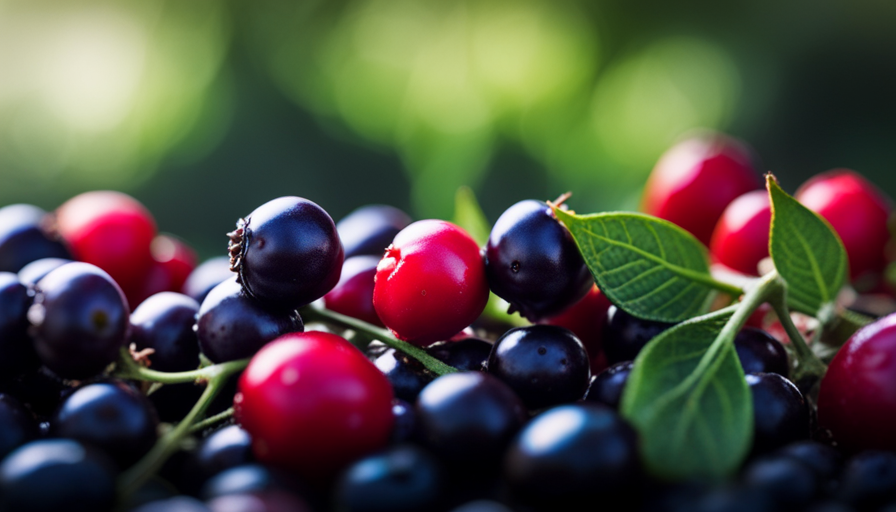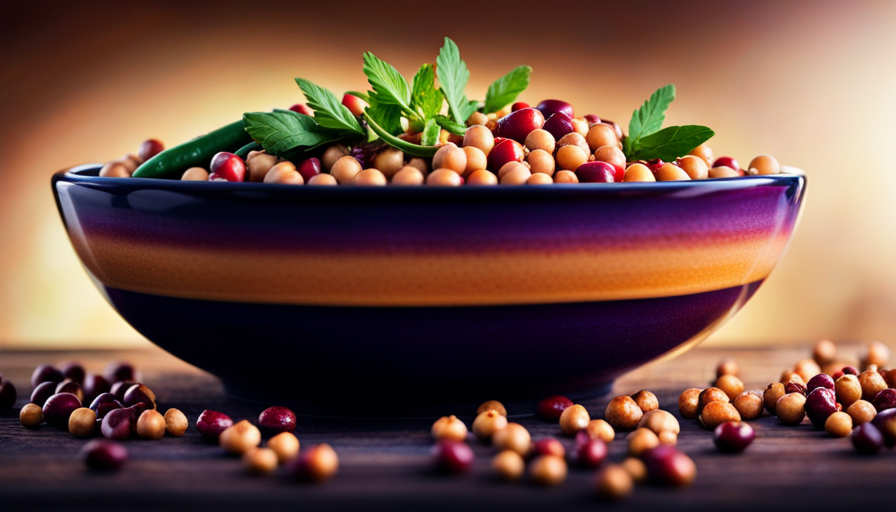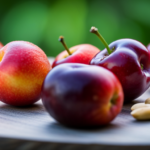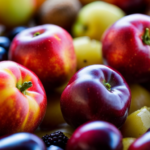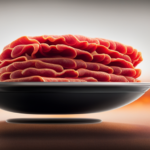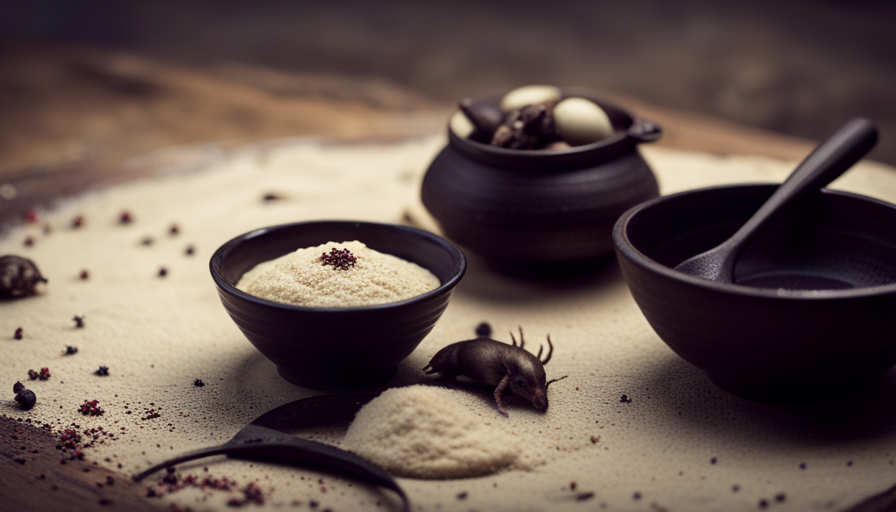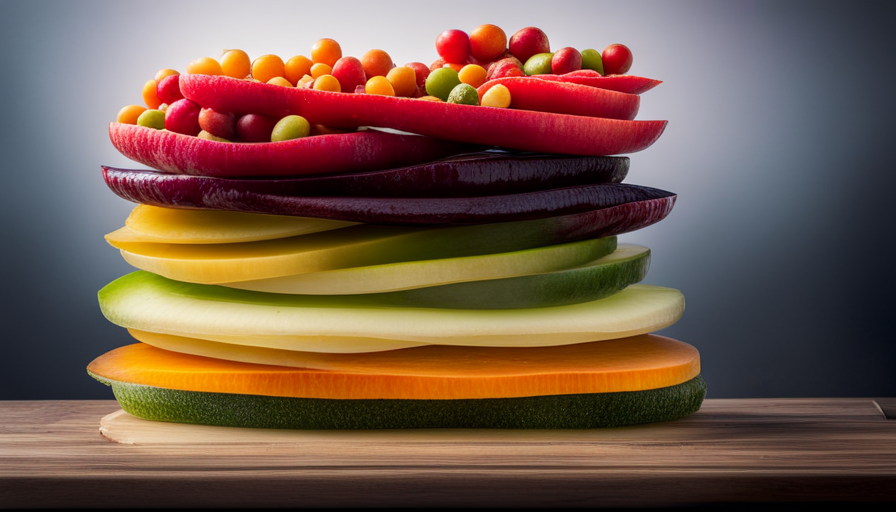Are you aware that some seemingly harmless foods can actually be dangerous if consumed raw? This is a commonly overlooked fact, but it’s crucial to understand the potential risks in our kitchens.
Just like a wolf in sheep’s clothing, these foods may appear harmless, but they can unleash a storm of toxins if not prepared properly. In this article, I will delve into the world of raw foods that can pose a threat to our health.
From the silky texture of a sunny-side-up egg to the savory aroma of a juicy steak, we often associate raw foods with culinary delights. However, beneath their delectable exteriors, raw eggs and meat can harbor bacteria and parasites that can wreak havoc on our digestive systems.
Additionally, certain varieties of fish, shellfish, sprouts, potatoes, kidney beans, rhubarb, and cashews may contain toxic substances that can lead to severe illness if consumed uncooked.
So, join me as we explore the hidden dangers that lie within these innocent-looking ingredients. By understanding the risks associated with consuming these foods raw, we can take the necessary precautions to protect ourselves from their toxic effects.
Let’s ensure our health and well-being by making informed choices in the kitchen.
Key Takeaways
- Raw eggs and raw meat, such as beef, pork, and poultry, can contain harmful bacteria like Salmonella, E. coli, and Campylobacter. Cooking these foods at high temperatures kills bacteria and improves their nutritional value.
- Certain fish, like tuna and mackerel, can contain toxins that are harmful when consumed raw. Cooking fish at high temperatures kills bacteria and parasites, making it safe to eat and allowing you to enjoy their health benefits, like omega-3 fatty acids.
- Raw shellfish, like oysters and clams, can accumulate harmful bacteria, viruses, and toxins. Proper handling and storage of shellfish is crucial to minimize the risk of foodborne illnesses.
- Unpasteurized dairy products and raw sprouts can harbor harmful bacteria and cause foodborne illnesses. Pasteurization effectively kills harmful bacteria in dairy products, and proper handling and storage of sprouts reduce the risk of contamination.
Raw Eggs
You should never eat raw eggs because they can make you seriously sick! Raw eggs can contain harmful bacteria such as Salmonella, which can cause food poisoning. Cooking techniques, such as boiling, frying, or baking, can kill these bacteria and make eggs safe to eat.
When eggs are cooked, the high temperatures destroy any potential pathogens present in the egg. This is why it’s important to always cook eggs thoroughly before consuming them.
In addition to eliminating bacteria, cooking eggs also improves their nutritional benefits. Cooked eggs are easier for our bodies to digest and absorb the nutrients they contain. Cooking eggs not only kills harmful bacteria but also enhances their nutritional value.
Eggs are an excellent source of protein, vitamins, and minerals. They contain essential amino acids that our bodies need to function properly. By cooking eggs, we can unlock their full nutritional potential and enjoy their benefits.
Transitioning to the subsequent section about raw meat, it’s important to note that like raw eggs, raw meat can also pose serious health risks. Therefore, it’s crucial to handle and cook raw meat properly to ensure its safety for consumption.
Raw Meat
Consuming uncooked meat can pose potential health risks due to its susceptibility to harmful bacteria. Raw meat, such as beef, pork, and poultry, may contain pathogens such as Salmonella, E. coli, and Campylobacter, which can cause foodborne illnesses.
However, there are also some benefits to consuming raw meat, such as increased nutrient availability and improved digestion.
When it comes to cooking raw meat, there are several methods that can effectively eliminate harmful bacteria. One common method is cooking the meat at a high temperature, such as grilling or broiling. This helps to kill any bacteria present on the surface of the meat. Another method is using a meat thermometer to ensure that the internal temperature reaches a safe level, typically 145°F for beef and pork, and 165°F for poultry. This is especially important for ground meat, as bacteria can be distributed throughout the meat during the grinding process.
While there are potential benefits to consuming raw meat, it’s important to take precautions to minimize the risk of foodborne illnesses. Cooking raw meat thoroughly using appropriate methods and temperatures is crucial to ensure the safety of the meat.
Next, let’s explore the potential risks associated with certain fish, such as tuna and mackerel.
Certain Fish (such as tuna and mackerel)
When it comes to fish like tuna and mackerel, it’s important to be aware of potential risks and precautions to ensure a safe and enjoyable dining experience. These fish can contain certain toxins that are harmful when consumed raw. However, by using proper cooking methods, you can eliminate these risks and still enjoy the health benefits of these fish.
One of the most effective cooking methods for certain fish, including tuna and mackerel, is to cook them thoroughly. This can be done by grilling, baking, or pan-frying the fish until it reaches an internal temperature of at least 145°F (63°C). Cooking at high temperatures helps to destroy any potential bacteria or parasites that may be present in the fish, making it safe to eat.
Cooking certain fish also allows you to reap their health benefits. Tuna and mackerel are rich in omega-3 fatty acids, which have been shown to reduce the risk of heart disease, lower blood pressure, and improve brain function. By cooking these fish, you can still enjoy their nutritional value while ensuring your safety.
As we move on to the next section about raw shellfish (such as oysters and clams), it’s important to understand the risks associated with consuming these types of seafood.
Raw Shellfish (such as oysters and clams)
Get ready to tantalize your taste buds with the exquisite flavors of raw shellfish like oysters and clams! When consumed raw, these delicacies can provide a unique and rich culinary experience. However, it’s important to be aware of the potential risks associated with consuming raw shellfish.
First, let’s talk about oyster farming. Oysters are filter feeders, meaning they obtain their nutrients by filtering water and consuming microscopic organisms. This process also makes them susceptible to accumulating harmful bacteria, viruses, and toxins present in the water they inhabit. Therefore, proper handling and storage of oysters is crucial to minimize the risk of foodborne illnesses.
Secondly, there are various clam recipes that showcase the natural flavors and textures of this mollusk when consumed raw. However, clams can also harbor harmful bacteria such as Vibrio parahaemolyticus and Vibrio vulnificus, which can cause severe gastrointestinal illnesses. It’s important to ensure that clams are sourced from reputable sources and handled with care to minimize the risk of contamination.
Lastly, consuming raw shellfish may also pose a risk for individuals with compromised immune systems, as they’re more susceptible to foodborne illnesses. It’s always recommended to cook shellfish thoroughly to reduce the risk of infections.
Now, let’s transition to the subsequent section about raw sprouts such as alfalfa sprouts, which also require careful consideration before consumption.
Raw Sprouts (such as alfalfa sprouts)
Indulge in the delicate and vibrant world of raw sprouts, like the enchanting alfalfa sprouts, as they transport your taste buds to a verdant garden of flavor and texture. Sprouts are not only delicious but also packed with numerous health benefits. Sprouting at home allows you to have fresh and nutritious sprouts readily available.
One of the key benefits of sprouting at home is that it ensures the freshness and quality of the sprouts. By sprouting them yourself, you have complete control over the process, from seed selection to harvest. This way, you can be confident that your sprouts are free from harmful chemicals or contamination.
Proper handling and storage of sprouts are crucial to maintaining their freshness and reducing the risk of foodborne illnesses. To properly store sprouts, keep them refrigerated at a temperature below 40°F (4°C). It’s also essential to rinse sprouts thoroughly before consumption to remove any dirt or debris.
Additionally, it’s important to handle sprouts with clean hands and utensils to prevent cross-contamination. Avoid consuming sprouts that have a slimy texture or a foul smell, as these may indicate spoilage.
As we move on to discussing unpasteurized dairy products, it’s important to note that sprouts, although nutritious when fresh and properly handled, can also pose a risk if consumed raw.
Unpasteurized Dairy Products
Raw sprouts, such as alfalfa sprouts, can harbor harmful bacteria and cause foodborne illnesses. Now, let’s move on to another potential danger lurking in our food: unpasteurized dairy products.
Unpasteurized dairy products are those that haven’t undergone the process of pasteurization, which involves heating the milk or dairy product to a specific temperature to kill harmful bacteria. While some argue that raw dairy products have health benefits and contain beneficial enzymes and bacteria, it’s important to note the risks associated with consuming them.
The main concern with unpasteurized dairy products is the potential for contamination with harmful bacteria, such as Salmonella, E. coli, and Listeria. These bacteria can cause severe illnesses, especially in vulnerable populations like pregnant women, young children, and those with weakened immune systems.
On the other hand, pasteurization has been proven to effectively kill harmful bacteria and reduce the risk of foodborne illnesses. It’s a critical step in ensuring the safety of dairy products and protecting public health.
While there may be arguments for the benefits of consuming unpasteurized dairy products, the risks of bacterial contamination and foodborne illnesses outweigh any potential advantages. It’s important to prioritize the safety of our food and choose pasteurized dairy products.
Moving forward, let’s explore another food that can be toxic when consumed raw: raw potatoes.
Raw Potatoes
Discover the surprising dangers lurking in your favorite potato dishes. Raw potatoes, while a staple in many cuisines, can actually pose potential health risks if consumed without proper cooking methods.
Although potatoes are a versatile and nutritious vegetable when cooked, their raw form contains toxic compounds that can be harmful to our bodies. Raw potatoes contain solanine, a naturally occurring glycoalkaloid that acts as a natural defense mechanism for the plant. When consumed in large amounts, solanine can cause symptoms such as nausea, vomiting, diarrhea, and even neurological symptoms like confusion and hallucinations. These toxic effects can be minimized through proper cooking methods, such as boiling or baking, which effectively break down and deactivate the solanine.
Cooking raw potatoes not only eliminates the potential health risks but also enhances their nutritional value. Heat breaks down the starches in potatoes, making them easier to digest and increasing the availability of certain nutrients. Additionally, cooking methods like boiling or baking can enhance the flavor and texture of potatoes, making them more enjoyable to eat.
Transitioning into the subsequent section about ‘raw kidney beans,’ it is important to note that just like raw potatoes, consuming raw kidney beans can also be hazardous to our health.
Raw Kidney Beans
If you’ve ever wondered why those homemade chili recipes insist on soaking your kidney beans before cooking, it’s because of the potential dangers they can pose if not prepared correctly. Kidney beans, scientifically known as Phaseolus vulgaris, contain a toxin called lectin. This naturally occurring compound is found in many plants and acts as a defense mechanism against predators. However, consuming raw kidney beans can lead to serious health risks due to the high concentration of lectin.
To eliminate the potential health risks associated with raw kidney beans, it’s crucial to cook them properly. Cooking methods such as boiling, pressure cooking, or using a slow cooker can effectively neutralize the lectin toxin. It’s recommended to boil kidney beans for at least 10 minutes to ensure the complete destruction of lectin.
Here are three important points to consider when cooking kidney beans:
-
Soaking: Soaking the beans overnight in water before cooking can help reduce the cooking time and further eliminate lectin.
-
Boiling: Boil the beans vigorously for at least 10 minutes to ensure proper toxin removal.
-
Avoid slow cooking on low heat: Slow cooking at low temperatures may not reach the required heat to deactivate lectin fully.
Now, let’s move on to another food that can be toxic when consumed raw – raw rhubarb.
Raw Rhubarb
Rhubarb, when not properly cooked, can pose potential health risks due to its high oxalic acid content. Oxalic acid is a naturally occurring compound found in various foods, including rhubarb. Consuming raw rhubarb can lead to the formation of oxalate crystals in the body, which can contribute to kidney stones and other health issues. Cooking rhubarb properly can greatly reduce the oxalic acid content and make it safe for consumption.
Despite the potential risks, rhubarb can still be enjoyed in various delicious and nutritious recipes. It’s a versatile ingredient that can be used in both sweet and savory dishes. Rhubarb compote, pies, and jams are popular choices for those looking to incorporate this tangy vegetable into their diet. Additionally, rhubarb can be used in salads, sauces, and even in cocktails for a unique twist.
Not only is rhubarb a flavorful addition to meals, but it also offers several health benefits. It’s a good source of vitamins C and K, as well as fiber. Rhubarb is also rich in antioxidants, which help protect the body against damage from harmful free radicals.
Now, let’s move on to the next topic of discussion: raw cashews.
Raw Cashews
Who knew that cashews, in their uncooked state, could be such an unsuspecting danger lurking in our kitchens? While cashews are a popular ingredient in many recipes, it’s crucial to understand that consuming them raw can have adverse effects on our health.
Raw cashews contain a toxic substance called urushiol, which is also found in poison ivy. This compound can cause skin rashes, itching, and even severe allergic reactions in some individuals. To avoid these risks, it’s recommended to always consume cashews that have been properly roasted.
Roasted cashews not only eliminate the harmful effects of urushiol but also offer numerous health benefits. Here are five reasons why roasted cashews are a better choice:
- Enhanced flavor: Roasting cashews brings out a delightful nutty flavor that adds richness and depth to various dishes.
- Improved digestibility: The roasting process helps break down the enzymes and fibers present in cashews, making them easier for our bodies to digest.
- Increased nutrient availability: Roasting cashews enhances the bioavailability of essential nutrients like vitamins, minerals, and antioxidants, allowing our bodies to absorb them more effectively.
- Extended shelf life: Roasting cashews helps extend their shelf life by reducing moisture content and preventing the growth of bacteria or mold.
- Versatile in recipes: Roasted cashews can be used in a wide range of recipes, from salads and stir-fries to desserts and granola bars, providing a delicious and nutritious addition to any dish.
While raw cashews may seem harmless, it’s important to be aware of their potential toxicity. Opting for roasted cashews not only eliminates this risk but also offers a variety of culinary and health benefits. So, next time you reach for cashews, make sure they’re roasted to enjoy both their flavor and nutritional advantages.
Frequently Asked Questions
Can consuming raw eggs lead to salmonella poisoning?
Consuming raw eggs can indeed lead to salmonella poisoning. Cooking eggs thoroughly kills harmful bacteria, such as salmonella, making them safe to eat. Cooking also improves the bioavailability of certain nutrients in eggs, such as protein and biotin. However, if you prefer not to cook your eggs, there are alternative methods of consuming them safely, such as using pasteurized eggs or opting for egg substitutes. These options reduce the risk of foodborne illnesses while still providing essential nutrients.
Is it safe to eat raw meat like steak or ground beef?
Raw meat consumption is a controversial topic with both pros and cons. On one hand, it’s argued that raw meat retains more nutrients and enzymes that are destroyed during cooking. However, the cons can’t be ignored. Raw meat may contain harmful bacteria and parasites that can lead to foodborne illnesses. Cooking meat not only eliminates these risks but also enhances its nutritional value by increasing the bioavailability of essential nutrients. It’s crucial to prioritize food safety and cook meat thoroughly to avoid potential health hazards.
What types of fish should I avoid eating raw?
When it comes to eating fish raw, there are certain types that should be avoided. These include tuna, mackerel, and swordfish, as they may contain high levels of mercury, which can be harmful to human health. Cooking fish properly is important as it eliminates any potential pathogens and parasites, ensuring food safety.
Additionally, cooking fish can enhance its nutritional value by increasing the bioavailability of certain nutrients.
Are there any health risks associated with consuming raw shellfish?
There are potential health risks associated with consuming raw shellfish. Raw shellfish can contain harmful bacteria and viruses, such as Vibrio and Norovirus, which can cause foodborne illnesses.
However, when cooked thoroughly, shellfish can be a good source of essential nutrients, including omega-3 fatty acids and vitamins. Alternative cooking methods like steaming or boiling can help kill any potential pathogens, reducing the risk of foodborne illnesses while still providing the health benefits of consuming shellfish.
Can raw sprouts like alfalfa sprouts be harmful to my health?
Raw sprouts like alfalfa sprouts can pose potential dangers to my health. They’ve been linked to outbreaks of foodborne illnesses, such as Salmonella and E. coli. The warm and humid conditions during sprouting create an ideal environment for bacterial growth. To minimize the risk, it’s important to take precautions when consuming raw sprouts.
These precautions include thoroughly washing them, avoiding cross-contamination, and considering cooking them before consumption to kill any potential harmful bacteria.
What Are Some Common Examples of Toxic Foods When Consumed Raw?
When the body obtains raw materials from toxic foods, it can lead to health issues. Some common examples of toxic foods when consumed raw include raw eggs, undercooked meat, and certain types of fish. These foods can contain harmful bacteria or toxins that may cause food poisoning or other serious illnesses.
Conclusion
In conclusion, it’s crucial to be aware of the potential toxicity of certain foods when consumed raw.
Raw eggs, meat, fish, shellfish, sprouts, potatoes, kidney beans, rhubarb, and cashews can all pose health risks if they’re not properly cooked.
As the saying goes, "an ounce of prevention is worth a pound of cure." Taking the necessary precautions, such as cooking these foods thoroughly, can help mitigate the risk of foodborne illnesses.
So, remember to handle and cook your food with care to ensure your safety and well-being.

